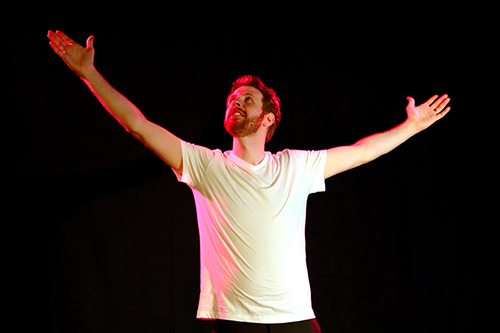Fringe Festivals
A year and a half ago I was stuck. I had written a one-man show as part of my undergrad honors thesis and I didn’t know what to do with it. My wife and I had recently moved to a new state for her to pursue an MFA in Costume Design, and I knew I wanted to work on producing my show outside of the protective incubator of school, but I had no idea how to go about doing that, especially in a new community where I had no connections. A local director I’d recently met suggested that I check out the fringe festivals in this part of the country. I had heard of fringe festivals before, but only had a vague sense of what they were, and how they operated.
Theater fringe festivals originated in Edinburgh Scotland back in the 1940’s, when eight theater companies turned up uninvited to an international festival. These rogue companies occupied the “fringe” spaces around the edges of the official festival, and that’s where the real excitement took place. Today, the Edinburgh Fringe is the largest arts festival in the world. The concept of fringe festivals—which differ from traditional theater festivals in that they are totally open so anyone can apply regardless of professional or amateur status, they are uncensored, usually not juried, they take place in a number of smaller venues, many of which are not traditional theater spaces, and tickets are usually extremely inexpensive thanks in no small part to the army of volunteers mobilized by the organizing company—first caught on in Canada, and finally made its way to the U.S. in the 1990’s. Today there are two-dozen fringe festivals in the U.S. alone, and it turned out to be the perfect venue for my little show.
I made it into both the Cincinnati and Indianapolis fringes, and after a few months of major rewrites, restaging with a new director, a crowd-funding campaign and a lot of rehearsing, we struck out for the Cincy Fringe. Occupying half a dozen random spaces in the Over the Rhine district of Cincinnati, the Cincy Fringe was awesome. The first thing to strike me was the sense of camaraderie among the participants. Here were other theater artists who were making shows, making art. I met young, innovative artists from all over the world. I saw more shows in two weeks than I had in two years, and it was still impossible to see everything I wanted. True to the nature of Fringe, some of it was pretty rough; certainly not the polished, pristine theater that was frankly starting to bore me. This was messy, edgy, and sometimes unsuccessful, but sometimes brilliant. I saw two young women from Liverpool perform in a coffee shop that transformed into a fringe venue at night, and I couldn’t stop thinking about their show, And All the Rest is Junk Mail for weeks. I saw Petunia and Chicken, a turn-of-the-20th-century love epic told with just two amazing, mime-and-clown-trained actors with no more than a hat and a scarf as props. I myself performed in a converted cafeteria in an art institute.

Above all, I was motivated and inspired. I hadn’t realized it, but I’d been checking my watch at plays a lot recently. Even with superb acting, brilliant scripts, and top-notch production values, theater can so easily lose its heart. What I found at the Fringe was the antithesis of polished emptiness. This was theater distilled, stripped down, and raw. Like I said, some of it was crap, but it was at least interesting, unique, unusual crap. Meanwhile some of it, like that show in the coffee shop, thrilled me like I hadn’t been thrilled in ages. I felt like I got back to the essence of what theater is: a viewing space, where worlds unfold.
Since Cincinnati I’ve been to fringes in Indianapolis and New York, and I’ve had the same inspiring experience in both places. I’m always motivated and inspired by this new generation of theater makers who are rolling up their sleeves and getting it done—often with no institutional support and very little in the way of funding. I think our generation is becoming increasingly disillusioned with the conventional wisdom that the way to achieve success is to be admitted entrance by the gatekeepers—the established producers, directors and companies etc. In an age when you can start a business and sell your product globally with nothing more than an Internet connection, the old, hallowed, dusty rungs on the ladder seem antiquated and unstable. Throw on top of that a major economic downturn and dwindling opportunities right as we try to enter the work force, and this is a generation that’s not going to wait until someone else hires us to create, whether it’s a business or a play. We are a generation that is realizing we can’t afford to count on anyone’s help but our own (over half of us don’t expect Social Security to exist when we retire), and it turns out the results are innovative and breathtaking.
Anyway, if you’ve never been to a Fringe festival, you must go. Go and see what the future of American Theatre looks like. Just be sure to see a bunch of shows because I’m not kidding, it’s a roulette game, and some of it’s crap, but that one that you just wander into because you’ve got some time to kill will be the play you tell your grandkids about.
Written by Ben Abbott
Marketing and Programs Coordinator for Performing Arts Abroad
To read more about Ben and his background go here.
